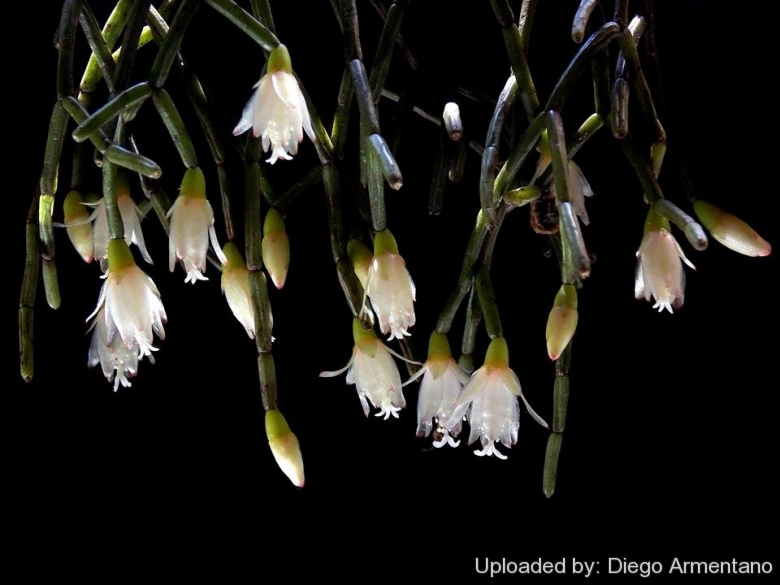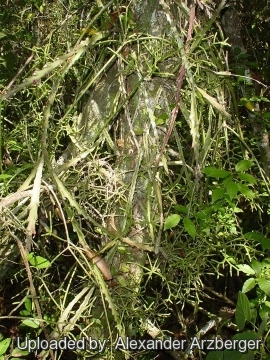Accepted Scientific Name: Rhipsalis cereuscula Haw.
Philos. Mag. Ann. Chem. 7: 112 1830

Hariota cereuscula (Rhipsalis cereuscula) Photo by: Diego Armentano
Origin and Habitat: Rhipsalis cereusculaSN|32874]]SN|32874]] is found in northeastern, eastern and south-central Brazil (Alagoas, Bahia, Mato Grosso do Sul, Minas Gerais, Paraíba, Paraná, Pernambuco, Rio de Janeiro, Rio Grande do Sul, Santa Catarina, São Paulo, Sergipe) to La Paz in Bolivia. It also occurs in northern Argentina (Corrientes, Entre Ríos, Misiones), Paraguay and Uruguay (Artigas, in the drainage of the Río Cuareím but also reported from Río Negro, Tacuarembó and others). This species has a very wide range and is presumably abundant.
Altitude range: It grows at altitudes between 200 and 1,400 metres above sea level.
Habitat and Ecology: Rhipsalis cereusculaSN|32874]]SN|32874]] is an obligatory epiphytic (or lithophytic) cactus that occur frequently on tree trunks, or sometime on rocks, in mata atlântica, including mata de brejo and mata agreste, and mata do planalto. It grows in lowland to submontane tropical moist forest. There is destruction of its habitat in northeastern Brazil due to agricultural and urban expansion. This is likely to occur in other parts of the range, too.
Synonyms:
See all synonyms of Rhipsalis cereuscula
back
Accepted name in llifle Database:Rhipsalis cereuscula Haw.Philos. Mag. Ann. Chem. 7: 112 1830Synonymy: 10
back
Common Names include:
ENGLISH: rice cactus, coral-cactus, Mistletoe Cactus
GERMAN (Deutsch): Korallenkaktus
Description: Rhipsalis cereusculaSN|32874]]SN|32874]], is a shrubby to bushy succulent epiphyte, to 60 cm long, sometimes referred as 'rice cactus' or 'coral cactus'. It is easily recognizable due to the multitude of tiny, cylindrical stems that are borne at the ends of long, slender branches. Plants are usually much branched, pendent and bear tiny creamy white bloom.
Stem: Stems and branches pale fresh green, terete, with determinate growth, acrotonical branching ( that is to say that it prefer to send sap to buds near the top of the plant) and strongly dimorphic (extension shoots and second-order and third-order stems of different lengths). Long extension shoots, slender, usually elongate, often erect, cylindrical, almost round in cross section, (7-)10-30(-60) cm long, 3-4 mm in diameter, crowned by an apical cluster of short branches and with numerous adventitious roots, attached to branches or tree trunks or erect to irregularly spreading and finally pendent, branching widely apically. Second-order shoots in clusters of 3–4 (–10 or more) at or near the tips of extension shoots, not always present, 4–10 cm long, spineless. Short terminal shoots (third order shoots) usually clavate, sometimes irregularly sausage-like, rarely much abbreviated and almost globose, in pairs or in dense clusters at the tip of second-order shoots or in groups of up to five from the tip of older third-order shoots, seeming to diverge at random, yet with a rhythm and grace, 2 to 6 times as long as thick, obscurely 4(or 5)-angled, 0.5–1.5 cm long, 2-4 mm in diameter.
Areoles: Closely set, composite, marginal, bearing 2 to 4 soon-caducous, short bristles. Bristles transparent, delicate, to 1.5 mm long.
Flowers: Diurnal, opening for several days, terminal or near the ends of the of third-order segments only, unscented, hanging down, bell shaped, lacking a hypanthium, white to creamy-pink, 8-15 mm long, 10-20 mm in diameter. Pericarpel green to pale yellowish green, globose to obconical, 4–5 mm in diameter, nude or occasionally with 1–2 reddish triangular scales, with or without bristles in their axils. Tepals about 11–15, the inner 7–8 slightly larger than the outer, 8–10 mm long and 3 mm wide, narrowly elliptic, white or pale creamy-white with yellowish midrib, tip faintly flushed pinkish, the outer elements more spreading. Stamens about 36, filaments white 7–10 mm long; anthers pale yellow. Style white, thin, 9–10 mm long, longer than the stamens and usually also exerted above the perianth; stigma lobes 3–5, spreading to recurved, whitish.
Blooming season: Winter-spring.
Fruits (berries): White or occasionally red outside Brazil, globose to obovoid 5–7 mm in diameter retaining shrivelled floral remnants at the top of the fruit, pulp strongly mucilaginous.
Seeds: Black
Remarks: Variability in R. cereuscula is not very pronounced, apart from some variation in fruit colour.
Subspecies, varieties, forms and cultivars of plants belonging to the Rhipsalis cereuscula group
 Rhipsalis cereuscula Haw.
Rhipsalis cereuscula Haw.- Rhipsalis simmleri Beauverd: has fine, dark green, lacy branches and is minuscule. The main branches spread out into hundreds of finer branches that bear creamy white blooms.
Bibliography: Major references and further lectures
1) N. L. Britton, J. N. Rose: “The Cactaceae. Descriptions and Illustrations of Plants of the Cactus Family.” Volume 4, The Carnegie Institution of Washington, Washington 4: 7. 1923 [24 Dec 1923]
2) Edward Anderson “The Cactus family” Timber Press, Incorporated, 2001
3) Taylor, N.P. and Zappi, D.C. “Cacti of Eastern Brazil”. Royal Botanic Gardens, Kew. 2004
4) Taylor, N.P. & Zappi, D. 2013. Rhipsalis cereuscula. The IUCN Red List of Threatened Species 2013: e.T152610A657007. http://dx.doi.org/10.2305/IUCN.UK.2013-1.RLTS.T152610A657007.en. Downloaded on 16 April 2016.
5) Hunt, D., Taylor, N. and Charles, G. (compilers and editors). “The New Cactus Lexicon.” dh Books, Milborne Port, UK.2006.
6) Keith Grantham, Paul Klaassen “The plantfinder's guide to cacti & other succulents” Timber Press, 18 May 1999
7) Clive Innes “Complete Handbook of Cacti and Succulents” Van Nostrand Reinhold Company, 01 December 1981
8) Sébastien Patiny “Evolution of Plant-Pollinator Relationships” Cambridge University Press, 08 December 2011
9) Urs Eggli, Eduardo Marchesi, Mauricio Bonifcino, Reto Nyffeler. “Taxonomy and distribution of epiphytic cacti in uruguay —notes Towards a checklis of cactaceae of uruguay, part 3” Haseltonia 14: 161–169. 2008
 Lepismium cruciforme, Rhipsalis cereuscula, Cordillera, Paraguay. (Rhipsalis cereuscula) Photo by: Alexander Arzberger
Lepismium cruciforme, Rhipsalis cereuscula, Cordillera, Paraguay. (Rhipsalis cereuscula) Photo by: Alexander ArzbergerSend a photo of this plant.The gallery now contains thousands of pictures, however it is possible to do even more. We are, of course, seeking photos of species not yet shown in the gallery but not only that, we are also looking for better pictures than those already present.
Read More... Cultivation and Propagation: Rhipsalis cereuscula is among the easiest to cultivate epiphytic cacti and tolerates neglect. These forest cacti tend to be long lived. Like a sea coral, the branching form of this plant provides fascinating texture both in mixed succulent plantings and as a single specimen plant. As the plant gains in size, the tops tend to arch - a perfect form for hanging baskets. These forest cacti tend to be long lived protect from chill and from high heat. Rhipsalis will thrive indoors, or in a protected area spring through fall outdoors.
Exposure: This plant (as with all Rhipsalis) prefers partial shade.
Watering: It requires ample summer water (more than other cacti), but allow soil to dry slightly between waterings. Occasional misting is appreciated in addition to light, weekly waterings.
Soil: These cacti won't want a normal cactus soil but will prefer to be in a soil largely composed of organic material, such as peat or sphagnum moss, This type of soil would normally be used for orchids, bromeliads or other epiphytic plants. Provide excellent drainage.
Hardiness: Frost tender, it must be brought inside over the winter in all but the most mild of climates. It needs night-time temperatures no cooler than 5° C, especially in the winter.
Special requirements: These plants bloom profusely if grown in an even, high temperature, but significantly less if the temperature fluctuates between 4°C and 18°C. They drop their buds easily if they are moved. Once flower buds have formed, do not move the plant, as slight changes in environment may cause the buds to drop.
Propagation: Stem cuttings.











